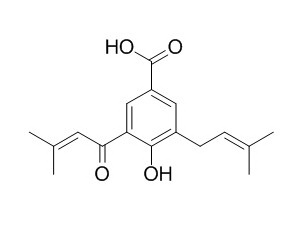4-Hydroxy-3-(3-methyl-2-butenoyl)-5-(3-methyl-2-butenyl)benzoic acid
Reference standards.
Inquire / Order:
manager@chemfaces.com
Technical Inquiries:
service@chemfaces.com
Tel:
+86-27-84237783
Fax:
+86-27-84254680
Address:
1 Building, No. 83, CheCheng Rd., Wuhan Economic and Technological Development Zone, Wuhan, Hubei 430056, PRC
Providing storage is as stated on the product vial and the vial is kept tightly sealed, the product can be stored for up to
24 months(2-8C).
Wherever possible, you should prepare and use solutions on the same day. However, if you need to make up stock solutions in advance, we recommend that you store the solution as aliquots in tightly sealed vials at -20C. Generally, these will be useable for up to two weeks. Before use, and prior to opening the vial we recommend that you allow your product to equilibrate to room temperature for at least 1 hour.
Need more advice on solubility, usage and handling? Please email to: service@chemfaces.com
The packaging of the product may have turned upside down during transportation, resulting in the natural compounds adhering to the neck or cap of the vial. take the vial out of its packaging and gently shake to let the compounds fall to the bottom of the vial. for liquid products, centrifuge at 200-500 RPM to gather the liquid at the bottom of the vial. try to avoid loss or contamination during handling.
Phytochemistry Letters2021, 43:80-87.
Compounds.2023, 3(1), 169-179.
GENENCELL2023, 25:4356740
FARMACIA2023, Vol.71,3.
Biol Pharm Bull.2023, 46(2):245-256.
The Journal of Internal Korean Medicine2015, 36(4):486-497
Phytomedicine.2018, 38:45-56
Molecules2022, 27(14):4601
Molecules.2023, 28(7):3039.
An Acad Bras Cienc.2023, 95(3):e20220672
Related and Featured Products
Planta Med. 2012 Jun;78(9):914-8.
Dihydrochalcones and benzoic acid derivatives from Piper dennisii.[Pubmed:
22516933]
METHODS AND RESULTS:
Two new dihydrochalcones (1, 2), as well as eight known compounds, piperaduncin C (3), 2',6'-dihydroxy-4'-methoxydihydrochalcone (4), 4,2',6'-trihydroxy-4'-methoxydihydrochalcone (5), 4-hydroxy-3,5-bis(3-methyl-2-butenyl)-benzoic acid (6), 3,5-bis(3-methyl-2-butenyl)-4-methoxybenzoic acid (7), 4-Hydroxy-3-(3-methyl-2-butenoyl)-5-(3-methyl-2-butenyl)benzoic acid (8), 2,2-dimethyl-8-(3-methyl-2-butenyl)-2H-1-chromene-6-carboxylic acid (9), and 3-(3',7'-dimethyl-2',6'-octadienyl)-4-methoxybenzoic acid (10) were isolated from the leaves of Piper dennisii Trelease (Piperaceae), using a bioassay-guided fractionation to determine their antileishmanial potential.
CONCLUSIONS:
Among them, compound 10 exhibited the best antileishmanial activity (IC50 = 20.8 µM) against axenic amastigote forms of Leishmania amazonensis, with low cytotoxicity on murine macrophages.
In the intracellular macrophage-infected model, compound 10 proved to be more active (IC50 = 4.2 µM). The chemical structures of compounds 1-10 were established based on the analysis of the spectroscopic data.



